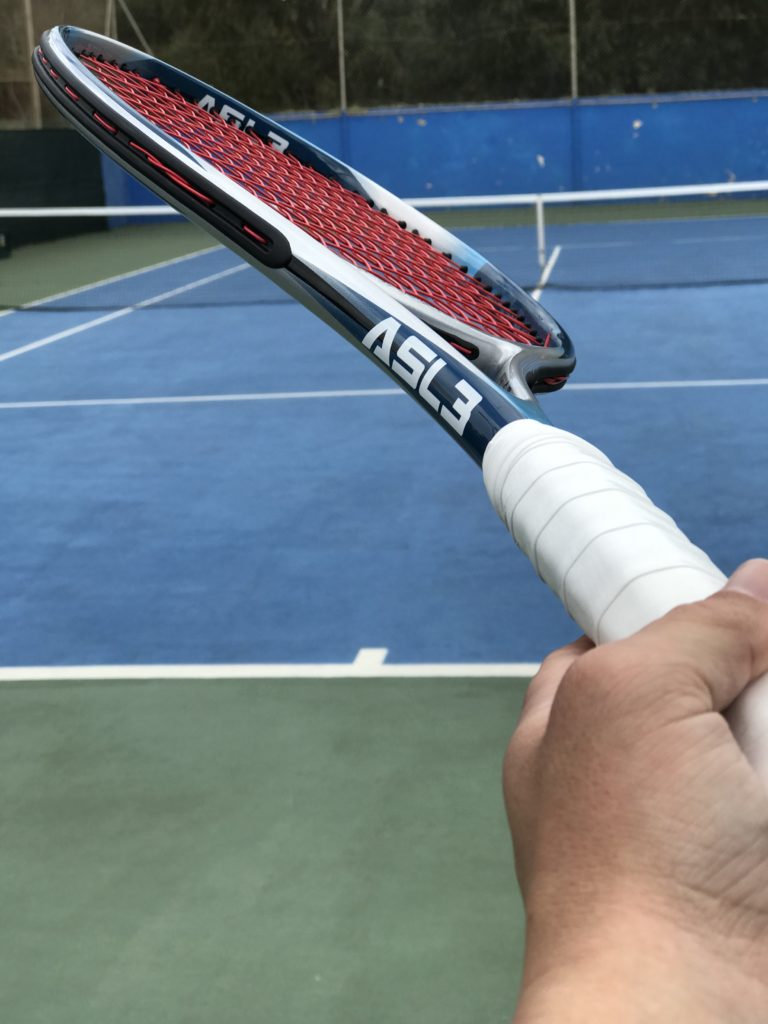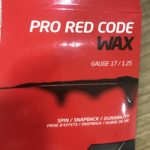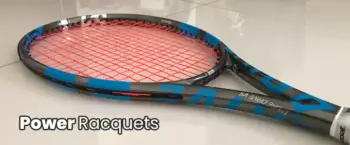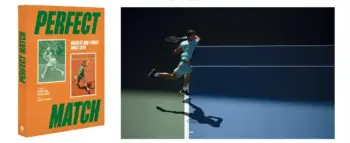Not long ago I reviewed the Angell K7 Lime and gave the racquet two thumbs up. This racquet is something quite different, but as this Angell ASL 3 racquet review will tell you, it is also remarkably good.
Angell tennis is broadening their product lines lately. Their custom line of racquets is also now facing internal competition from the K7 and the ASL racquets. As you know, I loved both the Angell K7 Red and Lime versions as they had an intoxicating flexible feel to them, but the Angell ASL 3 is catered to an audience that likes stiffer, more powerful racquets like the Babolat Pure Drive, Wilson Burn or HEAD Extreme series. Can it compete with these flagship brands? Read this Angell ASL 3 racquet review to find out.
Angell ASL 3 Racquet Review – Specs and tech
The Angell ASL 3 has a somewhat futuristic and clean look with silver, white and blue as the dominant colors. It offers a nice contrast to the black and copper design of the Angell Custom racquets and the paint job looks top notch. The ASL 3 comes with a layer of something called “active Siloxane” which is supposed to dampen the shock to the frame and also incoming ball speed. It is described like this: This immediate reduction in ball speed means less power is absorbed from the players swing and more pace is loaded onto the outgoing shot.
Like other Angell racquets, the frame comes with foam core to increase the solidity and stability of the frame.
These are the listed specs of the Angell ASL 3:
Headsize – 100?
String Pattern – 16×19
Weight – 295g / 10.4oz
Balance – 325mm / 6 pts HL (please note that the pic is likely a production typo)
Stiffness – 66 RA
Swing weight – 285
Length – 27” / 685.8mm
Beam Width – 21mm Hoop to 23mm Shaft
Grip type – High Tack PU White
Moulded PU handle – non-pallet
Colour – Metallic Silver / Blue
Angell ASL 3 Racquet Review – How does it play?
I have used the Angell ASL 3 (link to the Angell website) for a while now and although it is not a frame that I normally gravitate towards, I have had a lot of fun with it. It is more powerful and spin-friendly than my K7 Lime and I find myself hitting lots of winners on my forehand wing. The low weight and fast feel of this racquet makes it easier to increase your swing speed and really blast the ball. For a 295-gram-racquet it felt quite stable and the stiffness is noticeable but not jarring. It can’t really be compared to a Pure Drive since the beam is thinner and it has a lower flex rating, but the power level is still good. Not Pure Drive power, but it should be enough for most players.
I can compare it to a more low-powered Pure Drive VS (click for my review), that I tested recently, but I prefer the feel and comfort of the Angell ASL 3. I did hit plenty of winners with both racquets and I feel like both racquets need some customization to play more stable on volleys, but the ASL 3 is kind of what I hope the Pure Drive VS would play like. They have the same beam width, but I felt they took the Pure Drive VS a bit too high in the stiffness.
On volleys, the ASL felt a bit unstable in stock form and that improved when I added lead tape at 3 and 9 (four grams in total). I think I still need to add some more at 12 to be completely happy with the stability in volleys, but I do tend to play with heavier racquets. On serves, it came fast through the air and I felt like I could get good pace as long as I hit with good swing speed. It does not offer the get-out-of-jail-free serving power of the Pure Drive (click for my review) but gives you more control over the pace. So if you like a turbo-charged hitting experience, I think a Pure Drive might suit you better. But if you want an easy-to-use racquet with good power, nice spin and better control than most power racquets, give this one a try.
Angell ASL 3 Racquet Review – Summary
I was pleasantly surprised with this racquet. I normally go for heavier racquets or feel the need to weigh up racquets quite a bit before enjoying them, but the ASL 3 gave me my best hitting session in months. I felt like I could swing out, go for broke and still have the ball deep in. The power is more balanced in this racquet than many other power frames and I tend to prefer trying to generate my own power. The low weight also makes it easy for intermediate players to pick this up and use it, without any customization needed.
When you tend to hit with heavy racquets, it is nice to be able to really swing out at the ball with a frame like this. I really appreciated the fast feel, easy power, and good spin. I would have preferred a bit more weight, but you can always play around with lead tape. All in all, another nice racquet from Angell. Well-balanced in its performance and with a large playing demographic.
Angell ASL 3 Racquet Review – Video
What do you think of the Angell ASL 3? Is it something you would want to play with?



















Great review, as always. This sounds like a really interesting racquet for my level. Given the fact that the frame is substantially thinner that Pure Drives and other similar tweener frames, how does that affect the stability and power ?
Is the frame thickness any indicator of stability….? As most 100 cm2 frames seem to have the same thickness, 23/26/23 mm, I would guess there is some kind of reason behind it…..?
I play with a Volkl Vsense V1 pro with 23/20/23 mm and in general I love the racquet, but sometimes I feel it lacks stability and power. Tried lead tape etc but did not solve it for me.
I’ll stick with the racquet until I find something better……
How would this Angel ASL 3 compare with 295 gram Wilson Clash ? The specs seem very different.
Keep up the good work. TennisNerd rocks :)
Hi,
Thanks Alec! The power is good, but the Pure Drive is more powerful and like you mention I think it has to do with the thickness of the frame. A thicker beam should improve power and stability, but reduce comfort. The Clash has a very unique feel so the ASL 3 feels more like a traditional power racquet, while the Clash has this dual personality of a flexible racquet and a Pure Drive. I guess either you really like it or you don’t like it at all. Best to try before you buy!
Good luck / Jonas
Hi.
Interesting racket you reviewed here.
How sensitive is this racket on strings? You stringed it with a soft version string. Could it worked with for example MSV Focus hex soft or in a hybrid with Tecnifibre NRG2? Or could it matced better in custom v3 tc100?
Hi,
Thanks! I did not find this racquet to be very string sensitive. I like MSV Focus Hex Soft, so try that one in a hybrid with NRG2 – sounds like a good setup! Cheers / J
Hello Jonas ,
Thank you for this great review. I just have a little question : does the ASL3 have a big sweetspot? It is easy to use for a senior player ?
Thank’s in advance .
Best Regard
Rémy
Hi Rémy,
Thanks! Yes, the sweet spot is quite generous. I would recommend it to a senior player for sure.
Good luck / Jonas
Hello Jonas ,
Thank you for this great review. I just have a little question : does the ASL3 have a big sweetspot? It is easy to use for a senior player ?
Thank’s in advance .
Best Regard
Rémy
Hi, Will you test a extended length Angell TC100 or TC97?
Hi Steve,
I have already tested an extended Angell (TC 95), but not done a proper review of it. I really like Angell racquets, but prefer standard length sticks myself. If you are into extended-length racquets, I would recommend you to go for the TC 97 27.5 inch. The TC 97 is a brilliant frame.
Good luck / Jonas
Hi, tks for the review. I am currently playing with Volk V1 Pro Sense and it is the kind of stick that I like to play. Do you recommend the ASL3, or the ASL 2? Or should I try the K7 Red, or the Cyan? The Lime I thin it is to heavy
Hi, try the Cyan!
Hi Jonas. Been following your reviews and comments on injuries for a year now. Thanks for the education.
You had said you would test the non-extended Cyan whilst reviewing the XL version. Any idea when that would be? Apologies for my impatience.
Hi Kim, I don’t know exactly when, I will put it on the list.
Thanks for your reply